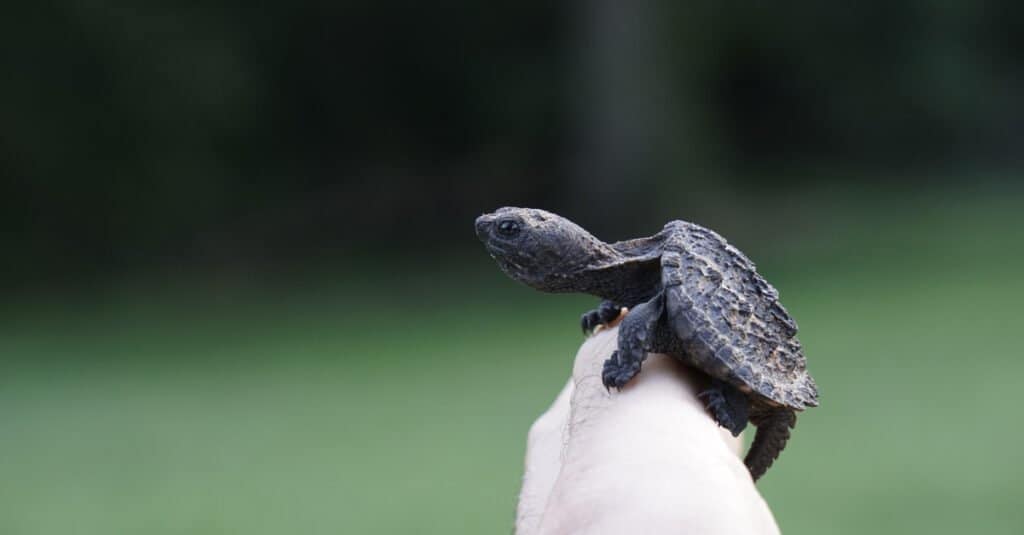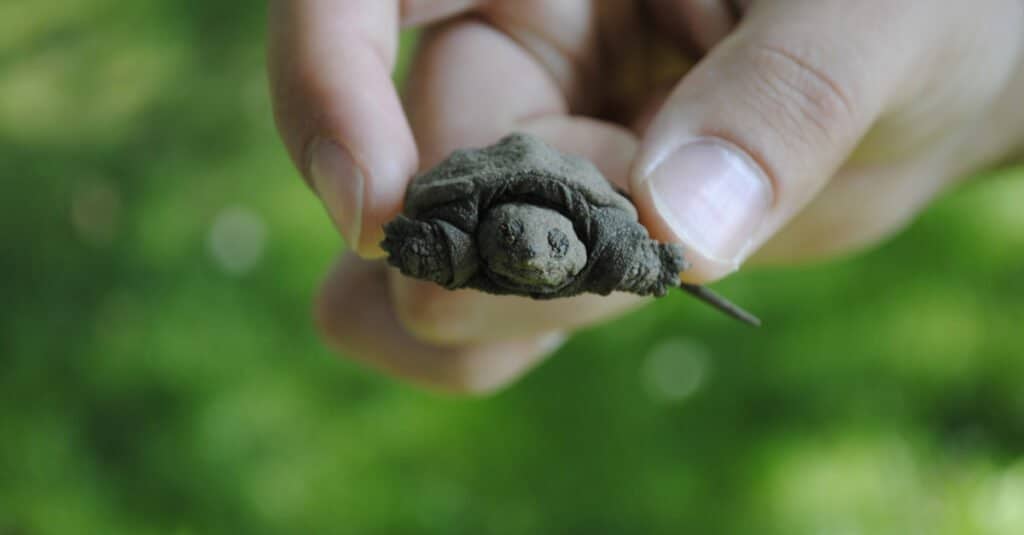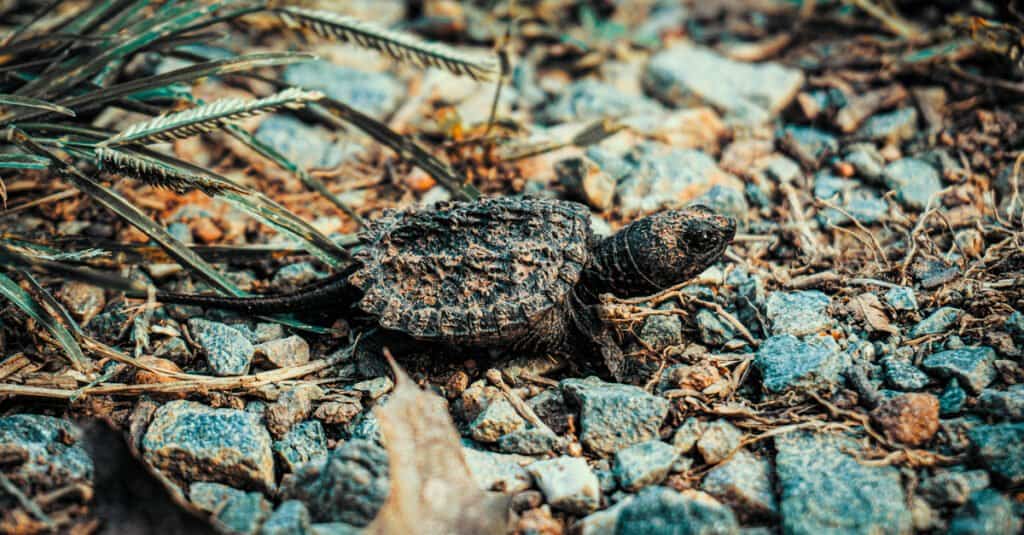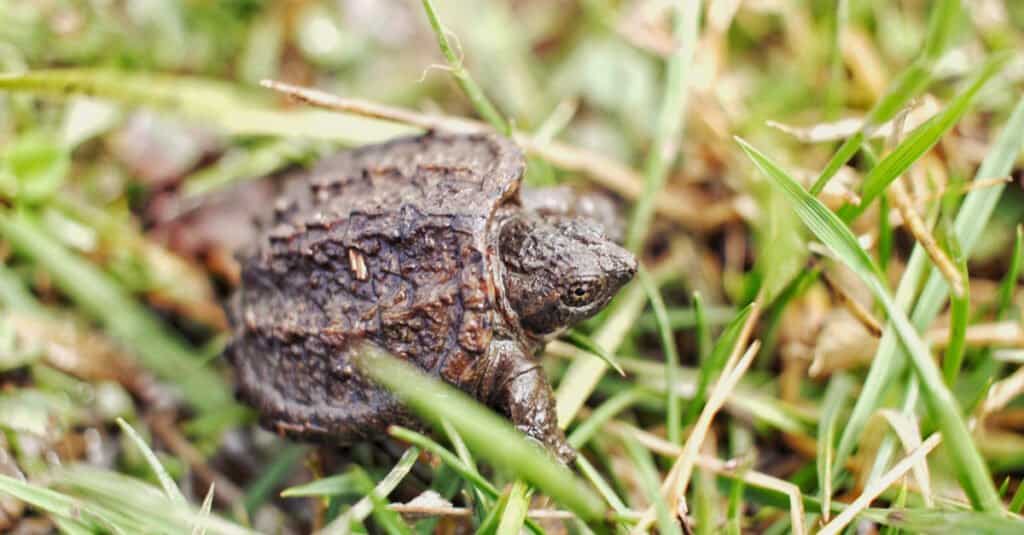There’s no doubt that baby snapping turtle hatchlings are astoundingly interesting creatures. Some species have incredibly long lifespans and are known for spending their lives in solitude. There’s no shortage of incredible things to learn about baby snappers, so let’s jump right in!
#1: A Baby Snapping Turtle is Called a Hatchling!

Newborn
snapping turtles
are called hatchlings!
©Hoth Cook/Shutterstock.com
Baby snapping turtles are reptiles, which means they come from eggs. Consequently, a newborn baby snapping turtle has just emerged from a shell. Like other turtles, alligators, and lizards, snapping turtle young are called hatchlings.
#2: Some Snapper Hatchlings Have Incredible Lifespans Ahead!

Baby Alligator
Snapping Turtles can live for more than 100 years!
©Jay Ondreicka/Shutterstock.com
Did you know that some baby snapping turtle hatchlings will go on to live for 100 years or more? For the baby alligator snapping turtle, this is a reality! This was first discovered when trappers found civil-war era musket balls and arrowheads embedded into an adult’s shell.
Even though baby alligator snapping turtles have an exceptionally long lifespan, the same is not true for all species. Standard snappers have an approximate lifespan of anywhere from 25 to 40 years. Some of the most impactful factors on a snapper baby’s lifespan are diet, environment, and quality of life.
Luckily, there is no shortage of baby snappers in the world today. According to the IUCN Red List, snapping turtles are considered a stable species. That means that there is no risk for endangerment or extinction today. However, habitat loss and human conflict continue to be a threat to baby snapping turtle populations all over the world.
#3: Snapping Turtle Hatchlings Get a Bad Rap

There are no recorded instances of a baby snapper taking off a human’s finger.
©JessKay/Shutterstock.com
Perhaps one of the biggest lies spread about baby snapping turtle hatchlings involves their mouths. Chances are, you may have heard that a baby snapper can take your finger off with a quick clench of their jaw. However, the truth is that there are no documented occurrences of this happening.
Scientists say that the jaw force of adult and baby snappers is about the same as the human jaw. Even though getting bit by a baby snapping turtle is sure to be unpleasant, it’s doubtful that you would lose any appendages. However, it’s still important to note that snapping turtles are notoriously aggressive and more prone to biting than other turtle species.
Even though they aren’t the friendliest of turtles, baby snappers are helpful in many ways. For example, they are exceptionally good housekeepers, known for consuming dead animals in ponds. They also prey on snakes, which is especially helpful for those that have personal or private ponds.
#4: Snapping Turtles Never Know their Mothers

Baby snappers can fend for themselves from birth.
©Hoth Cook/Shutterstock.com
You might be surprised to learn that baby snapping turtle hatchlings fend for themselves from the moment they are born. Female snapping turtles find a male to mate with, dig a hole, lay her eggs, bury them, and walk away. For the hatchlings’ entire lives, they will learn about the world with no guidance from a parent.
You might be wondering how a tiny baby snapper can survive in the world with protection. One major contributing factor is instincts. Even though their mothers never teach them how to swim or hunt, they instinctually know how to do so. Astoundingly, despite their lack of parental guidance, the mortality rate of baby snappers is just 22%.
Luckily, living a solitary life is no problem for baby snappers. From the moment they hatch, they actually prefer to be alone. Keep reading to find out why this isn’t a problem for these amazing animals!
#5: Snapping Turtle Hatchlings are Solitary Animals

Young snapping turtles prefer solitude since they’re so aggressive.
©Melanie_J/Shutterstock.com
As soon as baby snapping turtle hatchlings emerge from their shell, they prefer solitude. Even though they share a den with up to 50 other eggs, they don’t join forces with their siblings. Instead, they navigate to the water alone and go their separate ways. But why?
Perhaps the biggest reason why baby snappers prefer to be alone is due to their aggression. There’s no doubt that snapping turtle hatchlings don’t play well with others. In fact, it is not an uncommon occurrence for two snappers to fight when one gets too close. Consequently, baby snapping turtles stay far away from animals of their own kind.
Another contributing factor to baby snappers’ solitude is their hunting patterns. Even though they are known for their aggression, they are ambush predators. This means that they catch their prey by quietly waiting for an unsuspecting victim and taking them by surprise. Since solitude is the best way to go undetected, it makes sense that these amazing reptiles prefer to be alone.
The photo featured at the top of this post is © Hoth Cook/Shutterstock.com
FAQs (Frequently Asked Questions)
What is a baby snapping turtle called?
Like other turtles and many other reptiles, baby snapping turtles are called hatchlings.
How much do baby snapping turtles weigh?
Baby snapping turtle hatchlings are often so small that their weight doesn’t register on a scale. However, once grown, they will weigh between 40-175 pounds, depending on their species.
What do baby snapping turtles eat?
Baby snappers aren’t picky when it comes to their diet. Since they are too slow to hunt, they must wait quietly for unsuspecting prey to snatch up. Some of their favorite foods include small fish, reptiles, and aquatic insects.
Where do baby snapping turtles live?
Baby snapping turtle hatchlings prefer slow-moving lakes, ponds, and streams. They make their homes in the dense vegetation and love the muddy bottom.
Thank you for reading! Have some feedback for us? Contact the AZ Animals editorial team.






